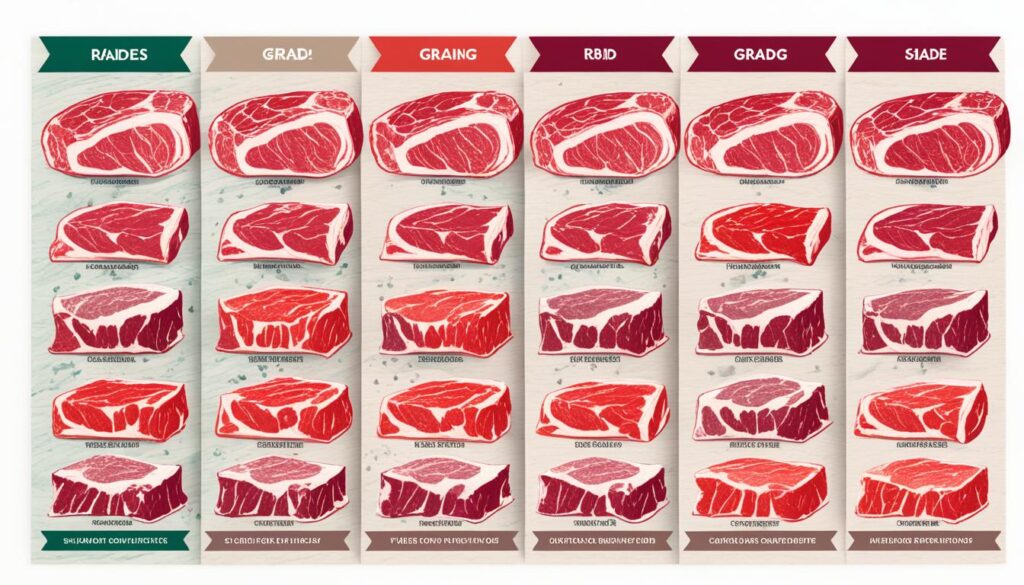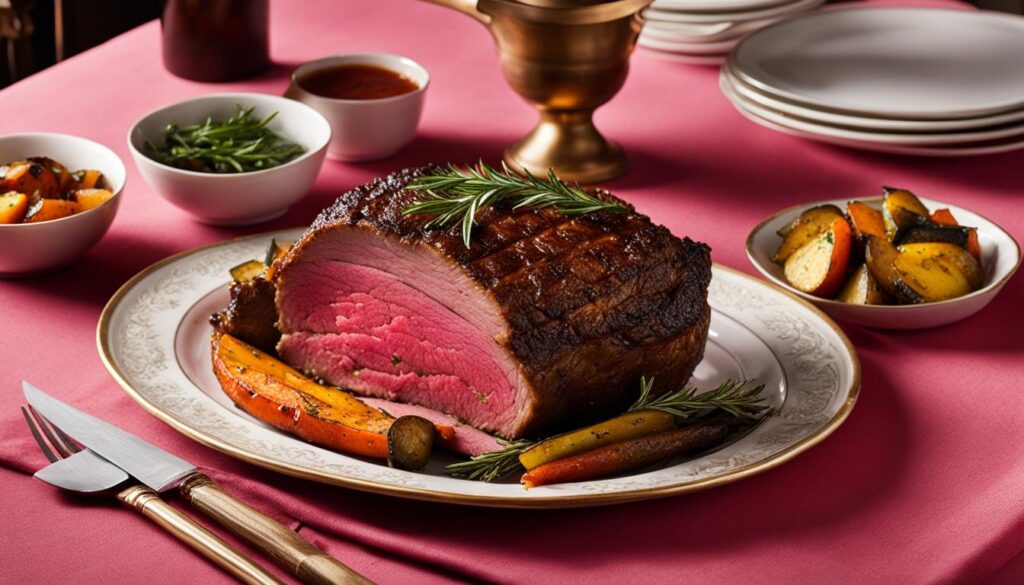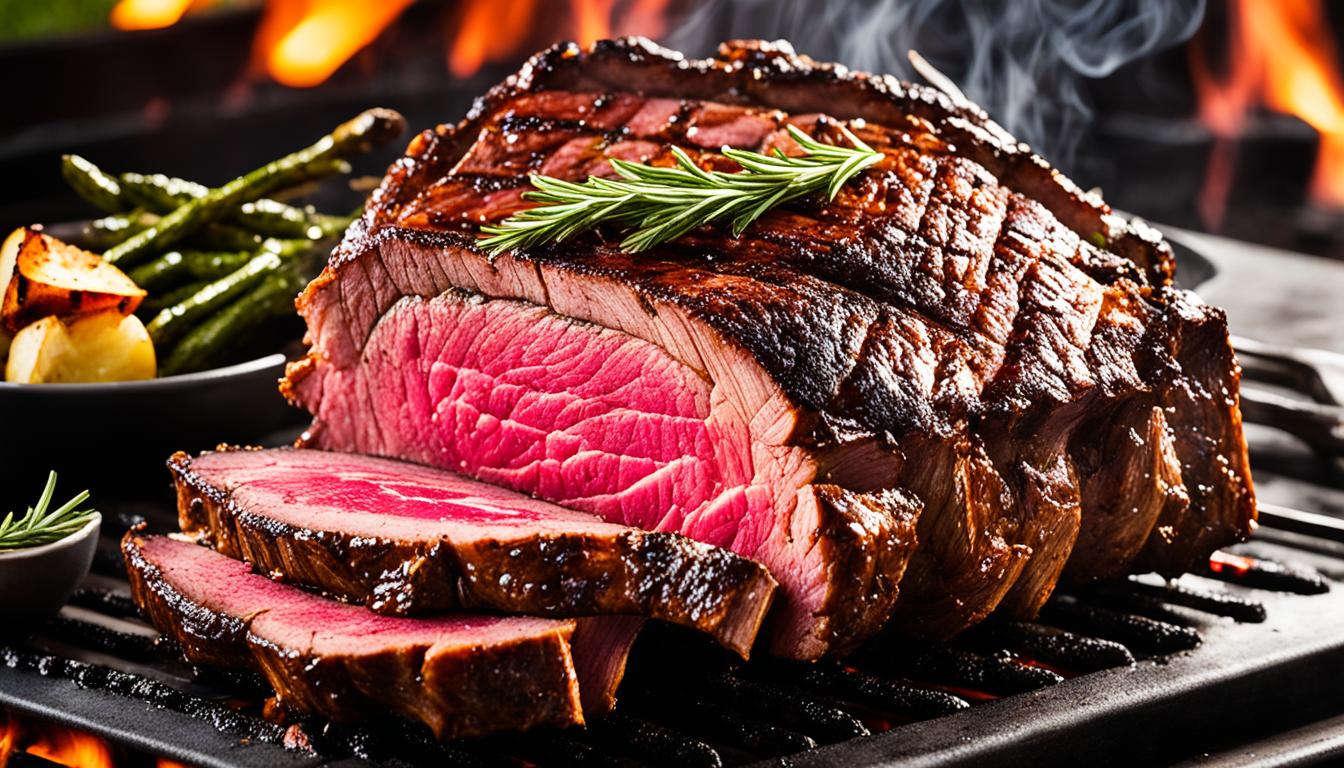Are you ready to learn the secrets to cooking the perfect prime rib? Look no further, because we have the ultimate food lab guide to help you achieve melt-in-your-mouth perfection every time. Whether you’re a seasoned chef or a beginner in the kitchen, our expert tips and techniques will take your prime rib to the next level.
From selecting the best cut of meat to mastering the cooking process, we’ll provide you with all the information you need to create a prime rib that will wow your guests. Say goodbye to overcooked or flavorless roasts, and say hello to a tender, juicy, and perfectly seasoned prime rib that will have everyone coming back for seconds.
With our food lab guide, you’ll discover the secrets to achieving the perfect balance of flavors, the ideal cooking temperature, and the proper resting time for the juiciest results. Get ready to elevate your prime rib game and become the envy of every holiday gathering with your culinary skills.
Key Takeaways:
- Our food lab guide will help you achieve melt-in-your-mouth perfection with every prime rib.
- Learn how to select the best cut of meat for maximum flavor and tenderness.
- Discover the secrets to seasoning, cooking, and resting the perfect prime rib.
- Master the art of achieving the ideal cooking temperature for juicy and perfectly cooked prime rib.
- Impress your guests with a prime rib that is tender, flavorful, and absolutely delicious.
What is Prime Rib?
Prime rib, also known as standing rib roast, is a tender and flavorful cut of beef from the center of the rib section of the steer. It consists of seven full ribs with a large eye of meat running along their backside.
This meat is part of the loin muscle, which is the same muscle that New York strips, ribeyes, and Delmonicos are cut from. Prime rib is often referred to as a standing rib roast because it is roasted and stands up.
Prime rib is known for its tenderness and flavor, thanks to the marbling, which is the intramuscular fat that lubricates the muscle fibers and adds to its juiciness.
The Loin Muscle: The Source of Prime Rib’s Flavor and Tenderness
The loin muscle is responsible for the characteristic tenderness and marbling of prime rib. This muscle runs along the spine of the steer and is not heavily used, resulting in a tender cut of meat. The marbling, or intramuscular fat, is distributed throughout the muscle and enhances the flavor, texture, and juiciness of the prime rib. It adds richness to the meat and keeps it moist during cooking.
Prime rib is often compared to other cuts like rib-eye steak because both cuts are derived from the loin muscle. However, prime rib is usually larger and cooked as a roast rather than individual steaks. The rib-eye portion of the prime rib is exceptionally juicy, flavorful, and coveted by meat lovers.
The Standout Qualities of Prime Rib
- Exceptional tenderness
- Rich flavor and juiciness
- Ample marbling for enhanced taste
- Large eye of meat for generous portions
- A worthy centerpiece for special occasions
The USDA Grading System
The USDA grading system is a classification system used to assess the quality of beef based on its tenderness and juiciness. This system ensures that consumers can make informed choices when purchasing beef.
The top grade in the USDA grading system is prime. Prime grade beef is known for its abundant marbling, which results in exceptional tenderness, juiciness, and flavor. Prime grade beef is typically sourced from cows under 42 months of age. However, it’s important to note that only around 2% of the beef sold in the United States is designated as prime.
The next grade is choice, which is the standard option at high-end supermarkets. Choice grade beef also has good marbling and provides a flavorful eating experience. It is a popular choice for consumers looking for a quality beef option.
Below choice grade is select grade, which is the most common grade found in standard supermarkets. While select grade beef may have less marbling than prime and choice grades, it still offers good flavor and tenderness.
It’s important to understand that grading is a voluntary process, and not all beef will have a grade. In addition to prime, choice, and select grades, there are other designations used to describe beef of lower quality, such as commercial, utility, cutter, and canner.
USDA Grading System Overview:
| Grade | Description |
|---|---|
| Prime | Abundant marbling, exceptional tenderness, juiciness, and flavor |
| Choice | Good marbling, flavorful eating experience |
| Select | Less marbling, still offers good flavor and tenderness |
Only around 2% of the beef sold in the United States is designated as prime.

Buying and Preparing Prime Rib
When it comes to buying prime rib, quality matters. We recommend purchasing the highest grade meat you can afford, such as prime grade or choice grade. This ensures that you’re starting with a top-notch cut of beef that will result in a melt-in-your-mouth dining experience.
As a general rule, plan on about half a pound of bone-in prime rib per guest. This takes into account the weight of the bones and allows for generous servings. However, if you prefer boneless prime rib, adjust the quantity accordingly.
Bone-in vs. Boneless:
Choosing between bone-in and boneless prime rib largely comes down to personal preference. A bone-in roast provides not only additional flavor but also helps regulate the temperature during cooking. The bone acts as a heat conductor, leading to more even heat distribution and a juicier end result. On the other hand, boneless roasts are easier to handle, carve, and serve.
Trimming and Tying:
Prior to cooking, it’s essential to trim any excess gristle or fat from the prime rib. This promotes even cooking and prevents flare-ups during roasting. Trim the fat down to about 1/4 inch for optimal results.
Additionally, tying the prime rib before cooking is a helpful technique. This holds the roast together, ensuring uniform cooking and preserving its shape. It also enhances presentation, giving your prime rib an elegant appearance.
When it comes to seasoning, simplicity can be key. A classic combination of salt and pepper is often sufficient to highlight the natural flavors of the prime rib. Alternatively, you can create a wet rub with garlic, rosemary, mustard, and olive oil for added depth of flavor.
| Bone-In Prime Rib | Boneless Prime Rib |
|---|---|
| Provides more flavor and juiciness | Easier to cook, carve, and serve |
| Aids in temperature regulation during cooking | Does not require tying before cooking |
| May require longer cooking time | Shorter cooking time compared to bone-in |
Remember, the key to a perfect prime rib lies in buying the best quality meat, making a choice between bone-in and boneless cuts, and taking the time to trim and tie the roast. By following these tips, you’ll be well on your way to serving a show-stopping prime rib that will impress your guests.
The Cooking Process
When it comes to achieving the perfect prime rib, the cooking process plays a crucial role. Searing the roast first helps to develop a flavorful crust, while roasting ensures the desired level of doneness. Here are the steps to follow:
- Searing the Prime Rib: Begin by heating a skillet over high heat until it is piping hot. Take the prime rib and sear it on all sides, allowing a dark brown crust to form. This initial searing will add a rich flavor to the meat.
- Roasting the Prime Rib: After searing, preheat your oven to 225°F (107°C). Place the seared prime rib on a rack in a shallow baking sheet. This allows the heat to circulate evenly around the meat, ensuring even cooking. Place the baking sheet in the center of the oven.
- Verifying Doneness: To determine the doneness of the prime rib, use a reliable meat thermometer. The internal temperature should reach around 125°F (52°C) for medium-rare or 130°F (54°C) for medium. Insert the thermometer into the thickest part of the meat, avoiding contact with bone or fat.
- Resting the Prime Rib: After cooking, it is essential to let the prime rib rest for at least 30 minutes. This allows the juices to redistribute within the meat, ensuring a tender and juicy final result. During this resting period, the internal temperature will continue to rise slightly.
Note: For detailed temperature and cooking time guidelines, refer to the following table:
| Level of Doneness | Internal Temperature | Cooking Time per pound |
|---|---|---|
| Medium-Rare | 125°F (52°C) | 15-16 minutes |
| Medium | 130°F (54°C) | 16-17 minutes |
By following these steps, you’ll be able to achieve a perfectly cooked prime rib that is seared to perfection, tender, and juicy.
Tips for the Perfect Prime Rib
To achieve the perfect prime rib, there are a few tips to keep in mind. First, temperature control is crucial. Cooking the roast at a lower temperature helps to ensure even doneness and minimize the gray band of overcooked meat. Searing the prime rib before roasting helps to develop a flavorful crust and enhance the overall taste of the meat. Additionally, using a thermometer to verify the internal temperature is essential for achieving the desired level of doneness. Letting the prime rib rest before carving allows the juices to redistribute and ensures a juicy and flavorful roast.
When it comes to achieving perfect prime rib, temperature control is key. Cooking the roast at a lower temperature allows the meat to cook evenly, resulting in a perfectly cooked, juicy, and tender prime rib. This is especially important to avoid a gray band of overcooked meat around the edges.
Before roasting the prime rib, it is highly recommended to sear the meat. Searing creates a delicious crust on the exterior of the roast, locking in the flavors and juices. To sear the prime rib, heat a skillet over high heat and add a small amount of oil. Place the roast in the skillet and sear it on all sides until a deep golden brown crust forms. This step adds incredible flavor to the meat and enhances the overall taste of the prime rib.
Using a thermometer to verify the internal temperature of the prime rib is essential for achieving the desired level of doneness. Different individuals prefer different levels of doneness, ranging from rare to well done. By using a thermometer, you can ensure that the prime rib reaches the perfect internal temperature for your preferences. For medium-rare, aim for an internal temperature of around 135°F (57°C), while for medium, aim for around 145°F (63°C).
Finally, letting the prime rib rest before carving is crucial for a juicy and flavorful roast. Resting allows the meat to relax and the juices to redistribute, resulting in a more tender and delicious prime rib. It is recommended to let the roast rest for at least 15-20 minutes before carving.
Our Recommended Temperature and Resting Time for Different Levels of Doneness:
| Level of Doneness | Internal Temperature | Resting Time |
|---|---|---|
| Rare | 125°F (52°C) | 15-20 minutes |
| Medium-Rare | 135°F (57°C) | 15-20 minutes |
| Medium | 145°F (63°C) | 15-20 minutes |
| Medium-Well | 155°F (68°C) | 15-20 minutes |
| Well-Done | 160°F (71°C) | 15-20 minutes |
By following these tips and techniques, you’ll be well on your way to achieving the perfect prime rib. The combination of temperature control, searing before roasting, and proper resting will ensure a prime rib roast that is tender, flavorful, and memorable. Happy cooking!

Conclusion
With the tips and techniques provided in our food lab guide, you can achieve the perfect prime rib every time. From selecting the right cut to seasoning, cooking, and resting, each step is important in creating a delicious and impressive roast. By following our expert advice, you’ll be able to impress your friends and family with a prime rib that is perfectly cooked, flavorful, and juicy.
So, put our guide to the test and enjoy the mouthwatering results of your culinary skills. The perfect prime rib is within your reach, and with our food lab guide as your companion, achieving perfection has never been easier.
Whether it’s a special occasion or simply a desire for a mouthwatering meal, the perfect prime rib will undoubtedly elevate your dining experience. So, fire up your oven, gather your ingredients, and embark on a culinary adventure with confidence and precision. With our food lab guide in hand, you’ll be well on your way to creating an unforgettable prime rib that will have everyone coming back for more.
